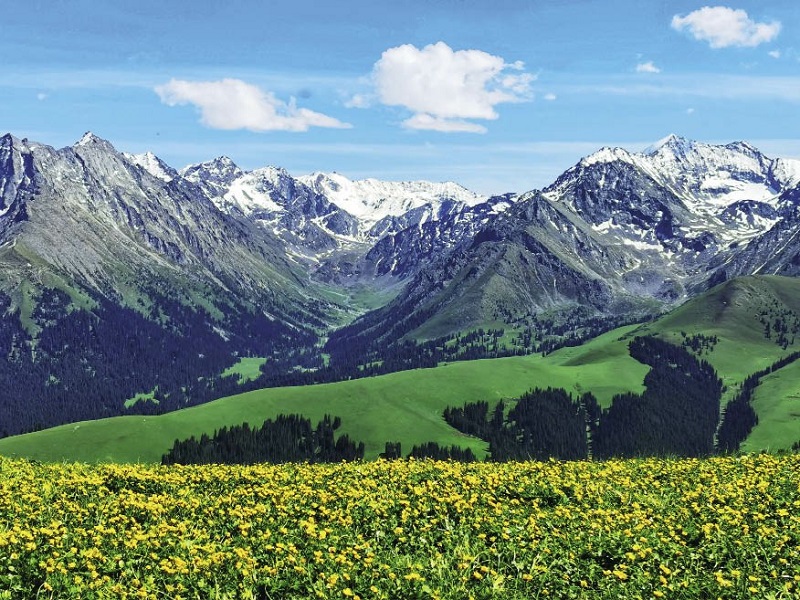
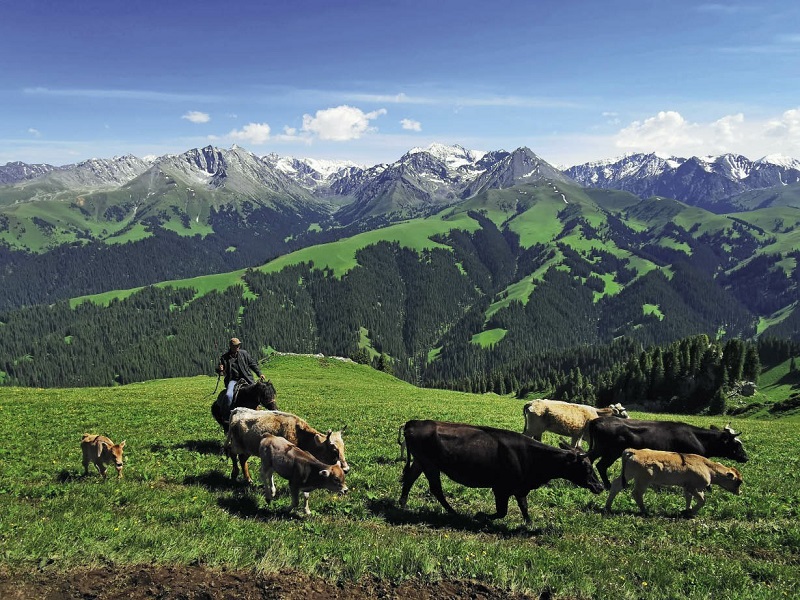
A local herdsman of Karajun looks after his herd of cattle grazing on the grassland.
Exotic Scenery
The months between June and September each year are always the most beautiful season for all the grasslands in Ili. As temperatures rise, snow gives way to lush carpets of new grass that soon fertilize oceans of flowers. The layer of the green grass stretches up along the beautiful winding mountains and deep into the spruce forests. It also helps breed a variety of wild flowers and provides feed for cattle, sheep, and horses that return every year to the grasslands to graze at their leisure. Herdsmen gallop their horses up and down the grasslands. Sayram Lake and Qiaxi are the two most unique scenic spots to see.
Sayram Lake is the highest alpine lake in Xinjiang and has the largest amount of water storage. Located 2,073 meters above sea level, it has a circumference of 86.05 kilometers and an area of 45,800 hectares. Even just driving around the parameter of the lake can take a few hours to complete. The meaning of the name Sayram Lake in Mongolian is “the lake on the backbone of the mountain,” whereas in Kazak it means “wishes and blessings.” It is the sapphire of the Tianshan Mountains and also often called “the last tear of the Atlantic Ocean.” Every year beginning in June, the lake is a stunning sight to behold, having the appearance of a giant blue mirror inlaid on a green carpet covered with red, yellow, blue, and purple wildflowers, with snow-capped mountains and mountain forests in the surrounding distance.
Qiaxi is famous for its “elegance.” There is a local saying, “Ili is a place with south China scenery, and Qiaxi is the most beautiful place in Ili.” It is a beautiful valley, with the Jirgalang River running through it. The river is flanked by mountain grasslands of moderate height on one side, and spruces and grasslands on the other, and guarded by distant snow-capped mountains on both sides. Deep in the valley, smokes float from white rock formations called obos leaving them enshrouded in pale mist. Adjacent to the snow-capped mountains, the grasslands are interwoven with spruce trees, hence the valley is nicknamed “Little Switzerland.” Legend has it that in ancient times, the king gave this place to a princess named Qiaxi who was fascinated with the scenery here.
In addition to these, vast expanses of rape flowers are in full bloom in Zhaosu County from mid to late July to August – you cannot miss seeing it. Tens of thousands of acres of rape flowers are miraculously transformed into a golden sea, spreading all the way to the foot of the Tianshan Mountains. Zhaosu is also the hometown of the Ili heavenly steed. Here, visitors can experience the thrill of seeing water spraying up from a herd of horses running through the river as well as the spectacular view of horses galloping down the hillside.
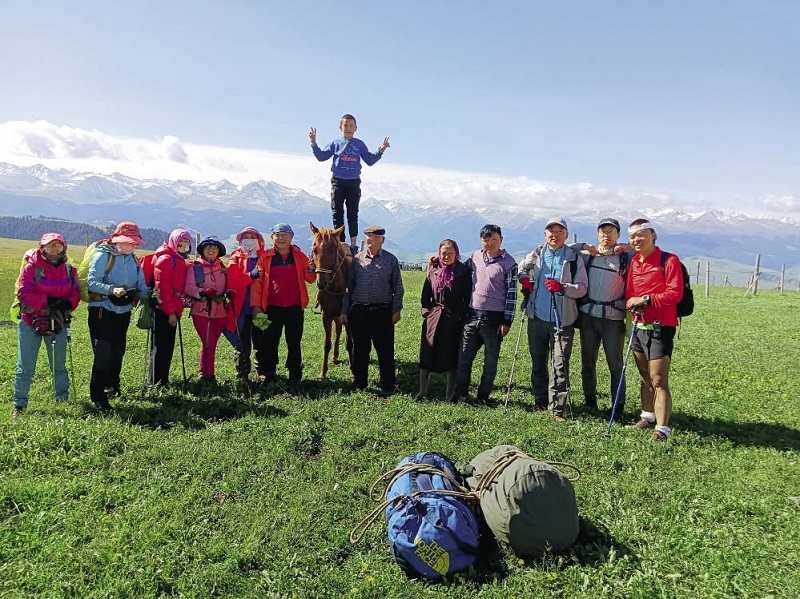
Bieke and his family pose for a photo with a group of tourists.
Experience the Primitive Karajun
Most of the grasslands in Ili are accessible by car, and still maintain their breathtaking beauty. But if tourists want to experience the more primitive, natural scenery and local culture, they need to take a hike into the more remote grasslands. The Karajun Trail is the most beautiful route in the Tianshan Mountains because of its beautiful scenery and low hiking difficulty. The trail from Ku’erdening to Qiongkushitai is 120 kilometers long, and it generally takes 6-7 days to complete a thru-hike. On the way the hikers will pass vast expanses of grasslands, dense forests and deep valleys, the essence of the Ili grasslands. The Karajun Grassland, in particular, is the cream of the crop for its amazing beauty.
The Karajun Grassland boasts 104 types of high-quality natural forage, making it a classical alpine grassland with an abundance of rainfall and lush vegetation in the summer despite the cool weather. It has been considered as a rare vast alpine grassland in the world by the Food and Agriculture Organization of the UN (FAO). In 2013, it joined the Tianshan Mountains to be included in the World Natural Heritage List.
As the reputation of Karajun has spread, the number of visitors here is growing steadily. But due to the vast expanse of the region, the places that tourists can reach are quite limited. As a result, the area is still the main grazing pasture area for Kazak people’s livestock during the summer time. Every summer there are around 300,000 livestock of all sizes that roam through the region, helping maintain the original ecology especially deep in the grasslands. For trekkers, walking through the region is not very strenuous. They are surrounded by picturesque scenery everywhere: under a blue sky dotted with white clouds, wildflower meadows stretch afar, with herds of oxen, sheep, and horses scattered here and there, and snow-capped mountain ranges far off in the distance.
In addition to the stunning views of the grasslands are the unforgettable memories of experiencing the daily life of local people. Finding a place to stay each night at a herdsman’s home, eating the fresh and tender mutton, drinking fresh milk, enjoying milk tea made of milk and butter with the special local flat crusty pancake called nang, and hearing locals tell stories about the constants and changes of their life are all aspects of the local culture to enjoy.
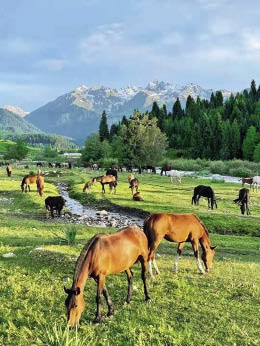
A herd of horses and cattle graze in the countryside of Qiaxi.
Muheiti is a typical herdsman on the grasslands. His home is located in the most primitive stretch of land along the eastern part of the Karajun Trail. Nearby his home is an immense forest with far distant snow-capped mountains as a backdrop. When the sunlight changes at sunset and sunrise, the grassland here looks like a picture scroll unfolding in front of you. His family has just completed building a new yurt to accommodate coming tourists. Presently, the main source of the herdsman’s income is raising pasture animals. Early in the morning every day, he rides on horseback and takes his cattle and sheep herds to feed on a grassland located a distance from home. His beautiful wife works hard milking cows morning and evening to harvest two barrels of milk every day. In addition to providing milk for the family, most of the milk is used to produce a local dairy product called drained milk or cheese that can be sold for money.
Compared with the Muheiti family, Wumu Erjiang and Bieke live a more modern lifestyle, having diverse sources of income while maintaining their traditional culture. Wumu Erjiang is a bright young man who can both speak and write Chinese and has a good sense of humor. His family spends the summer leading their livestock to graze in an area of Karajun called Jiasagan. Although he owns a motorbike and a pickup truck, he still loves horseback riding and tutors young people he sees who are learning how to ride a horse. In addition to herding, he houses tourists in his yurt and carries trekkers’ luggage on his horse. Bieke’s ranch, on the other hand, is located in a place called flower terrace, with a vast expanse of open fields and blossoming flowers all around. It is a very good place to watch sunsets and sunrises. More than a decade ago this place had already become famous among trekkers. Over the past decade, he has grown from a young adult into a father of a nine-year-old child, and his family runs several yurts. What is special about the family is that they still maintain and love their nomadic life of herding animals. In the evenings, they also sing, chat and drink with friends and neighbors.
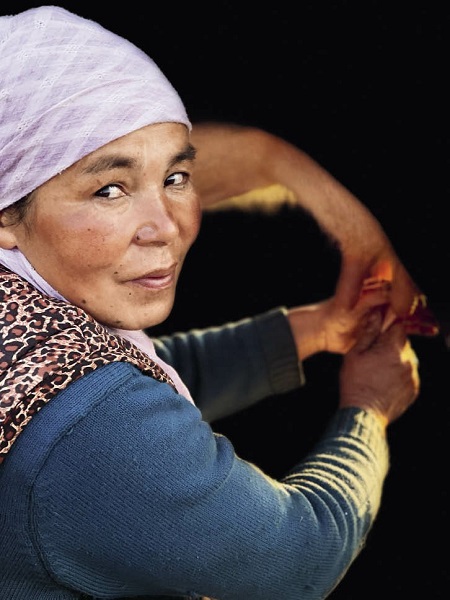
Muheiti’s wife carries out her daily work of milking cows.
Living Harmoniously in a Multiethnic Culture
Ili is not only blessed with beautiful natural scenery, it also is home to 13 ethnic groups including the Kazak, Uygur, Hui, Mongolian, Han, Xibe, Ozbek, and Tatar, who all live harmoniously together. All these ethnic groups have left their own deep cultural imprints on the Ili region. Yining Liuxing Street is a typical residential area of ethnic integration, where the Han, Kazak, Uygur, Hui, and other ethnic groups live alongside each other, while their houses have their own characteristics. Milk tea, flat crusty pancakes, roasted stuffed buns, mutton, and other special foods are popular among local residents and tourists. Kazanqi is a neighborhood with the majority of its population, more than 77 percent, being Uygur people, who still live their traditional lifestyle. Mosques and traditional handicrafts with ethnic characteristics are available throughout the streets there.
The reason why local people coming from multiethnic backgrounds can peacefully live together in Ili is closely associated with Kazak people’s traits of being honest, warm-hearted, and hospitable, in addition to the efforts of the government to unite the locals. Jierguna is from a classical Kazak herdsman family. During the summer, the family lead their herds to feed on the Kongdunasu Grassland. In addition to building a yurt on the lush grassland for themselves to dwell in, they have also built an extra one to host tourists. Even hikers like us who are merely passers-by, are welcomed into their yurt, asked to remove our shoes and sit above the salt, and treated with local milk tea, fresh milk, and crusty pancakes. If you become a friend of them, they will treat you as a relative, and invite you to stay for the night.
Being a Kazak autonomous prefecture, Ili has inherited and passes on the Kazak culture, and many of their ancient customs are still practiced today. The Kazak people living on the grasslands still preserve the characteristics of nomads. They attach great importance to the birth and growth of lives, thus they celebrate several rituals throughout the growing years of their children. Some of the ceremonies they observe are the birth ceremony, naming ceremony, learning to walk ceremony, riding a horse ceremony, and coming of age ceremony. The learning to walk ceremony is held on the first birthday of a child, signifying the keen interests Kazak people place on the beginning of a life. On the day of the ceremony, the host will slaughter a sheep to serve at a special meal and hold recreational and sports activities to celebrate the event. The child’s feet are tied with a colored rope made from black-and-white yarn and catgut strings, which, as if a “shackle” on the child’s legs, symbolizes the winding road of life. Cutting off the rope for the child indicates that the child has succeeded in making the first step in life.
REN ZHAOXIA is a travel columnist.